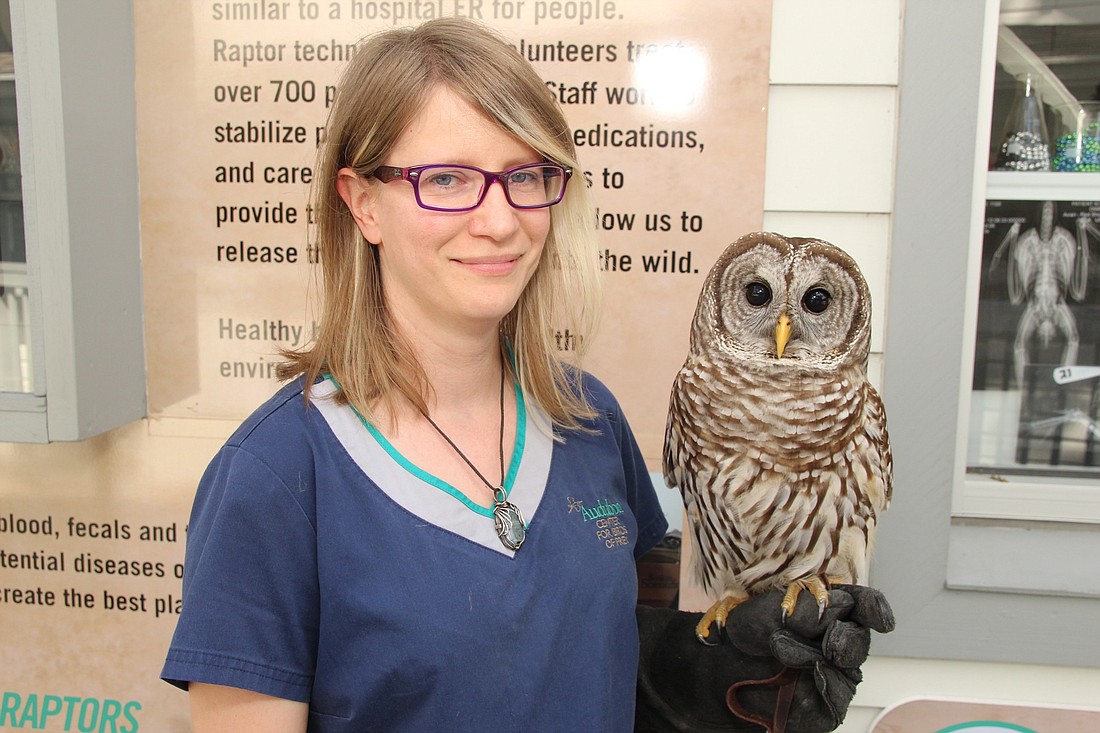- April 18, 2024
-
-
Loading

Loading

The Audubon Center for Birds of Prey has spent 40 years taking in and rehabilitating birds of prey species from across Florida. But it can’t do it alone.
The animal conservation group is hosting its Wind Beneath Our Wings fundraiser, a celebration of 40 years of raptor conservation and education programs, Sunday, Feb. 24. This year’s event is expected to attract more than 180 patrons and community members gathering to support the center.
There also will be a few feathered friends in attendance. The center’s bird ambassadors — an assortment of trained bald eagles, ospreys, red-tailed hawks and owls — will be present for guests to admire.
“It’s amazing to have guests come here and meet our birds,” Director Katie Warner said. “They help us tell our story about how these (birds) are all around Florida and why that’s important and why it’s important to protect our water, our land, and what you can do to help them.”
Feathered Friends
Audubon Center staff view raptor rehab as important, rewarding work. But between managing long-term injuries, surgeries and rehabilitation that can take up to a year, it also can be expensive.
“On average, it’s about $3,000 to treat and rehabilitate a bald eagle,” Warner said. “The 600th eagle (we released) was almost $5,000. Some are a lot less, it varies on the species and injury.”
Through a series of community foundation grants, family grants, corporate supporters and ticket sales, the Audubon Center has an annual budget of $500,000 to $600,000, Warner said. The center medically treats 600 to 800 birds of prey each year and has admitted more than 21,000 birds since 1979.
The Wind Beneath Our Wings fundraiser traditionally draws in a little more than 10% of that annual budget for the center each year. The group raised $53,000 through sponsorships and a silent auction at its 2018 function and is looking to beat that number in 2019. Warner said it’s a donor-focused event. Money can be pledged to a specific initiative like the center’s clinical care, EagleWatch initiative or educational programs.
“A lot of our (donors) are drawn to our event’s animal connections; they like to donate to clinical costs,” Warner said. “Our biggest cost is the clinic, food, medication — all of that.”
This year’s function features a live auction with two special prizes — a 25-person “Owls and Other Spirtis of the Night” event hosted at the Audubon Center with drinks from the Winter Park Brewstillery, and the chance to release one of the center’s bald eagles. Growing Bolder network executive vice president Bill Shafer is the guest speaker for the evening.
Although the original Wind Beneath Our Wings fundraisers were at the center itself, this will be the first year Audubon staff and patrons will celebrate their hard work at Harry P. Leu Gardens.
Maitland has a long history with the Florida Audubon Society. The organization’s first meeting was held in Maitland in 1900. Some of the group’s first officers were New York governor and future U.S. President Theodore Roosevelt and Rollins College President G.M. Ward. The society’s center for birds of prey was established in 1979.
Wear & Care
Samantha Little, a certified raptor vet technician, oversees every animal that arrives at the center and the care that they receive.
Just last week, Little and center staff took in a cooper’s hawk that was hit by a fire truck and stuck in its grill in Seminole County. Center staff, comprising six full-time staff members and more than 80 volunteers, inspected the hawk for fractures, looked for wounds or trauma and concluded the lucky animal only had lost some feathers.
Some cases are more severe. Little recalls baby ospreys that were in nest fires after being struck by lightning. Cases in which the animal loses a majority of its feathers can take nearly a year to finish rehabilitation. About one-third of the birds the center takes in are babies that have fallen from their nest, Little said.
When birds of prey are seriously injured in territory fights, which has been the case with some of its bald eagles, they need periods of wound care and occasionally laser treatment to accelerate the healing. Between the initial exam, food and medication, laser therapy, radiographs and blood work, eagle care can cost close to $5,000.
Little also cares for the ambassadors, the group’s 45 birds that are unable to be safely released back into the wild and are permanent residents at the center. Many of those birds were taken in as babies, have been glove trained and now visit school’s and community events as part of the center’s educational programs.
Maple, a barred owl who broke her leg in a fall and never recovered, has racked up $8,000 in costs in her first year. Much of that is simply food. The owl eats $20 a day in mice, chicks and other animals. Frances, a bald eagle that has been with the center for nearly 28 years, has cost more than $307,000.
EagleWatch
The Audubon Center also takes a proactive stance in bird conservation. It is part of the EagleWatch program, which has more than 300 volunteers across Florida monitoring eagle nests from October through May. They collect data on productivity to make sure there are no impacts to the eagle population, Warner said. Sometimes, they even track if chicks or birds have fallen out of their nests and help with rescues.
“Eagles are indicators of a lot of other things that are going on in Florida,” Warner said. “Certainly water quality, habitat loss — those are the biggest factors affecting them. This helps guiding management and policy in our state.”